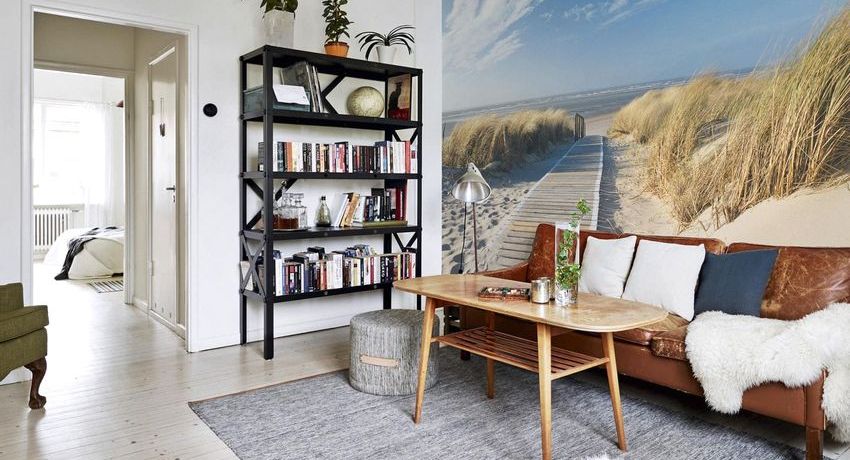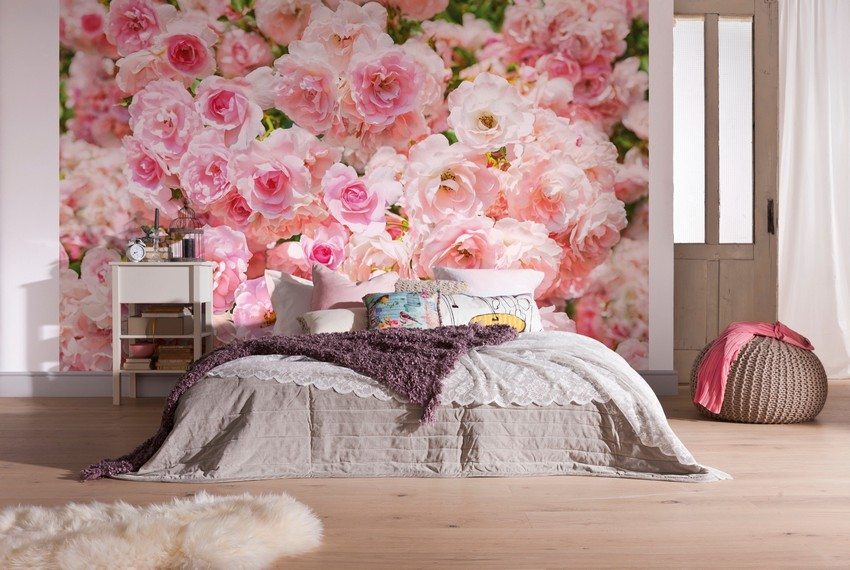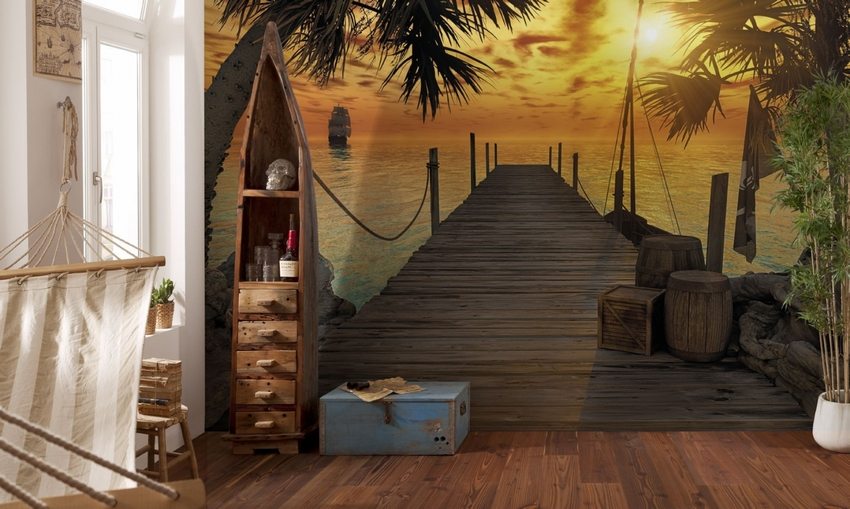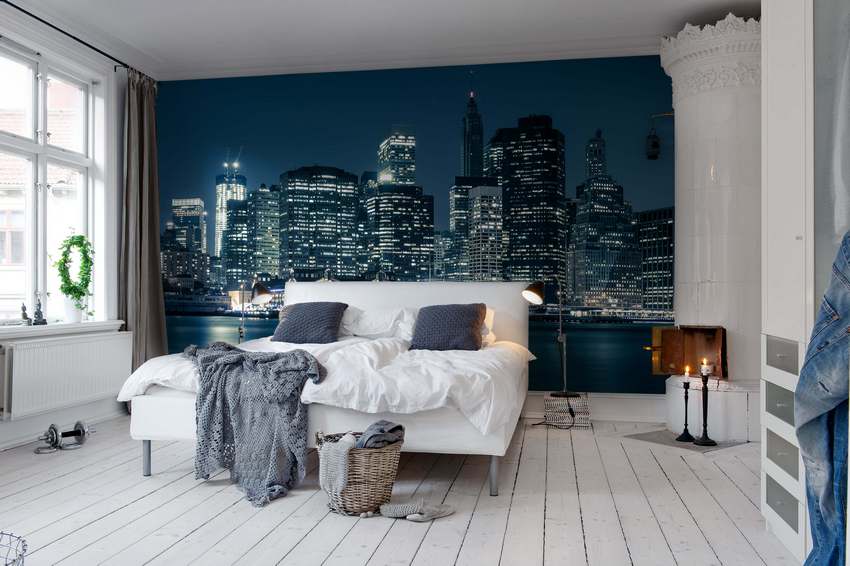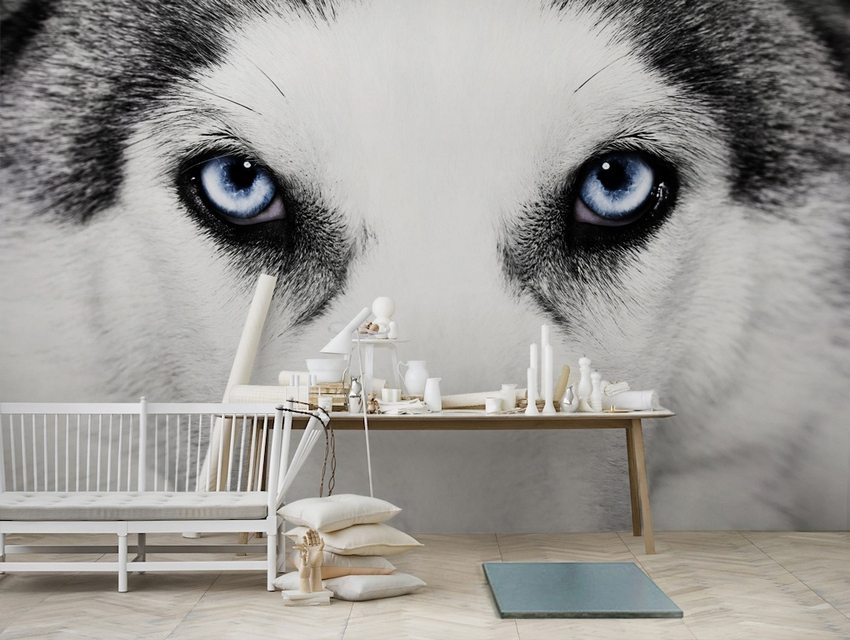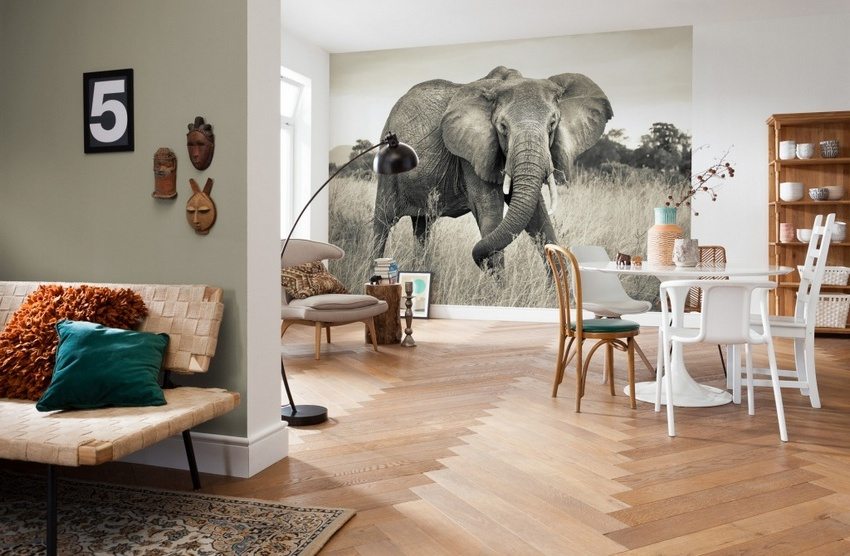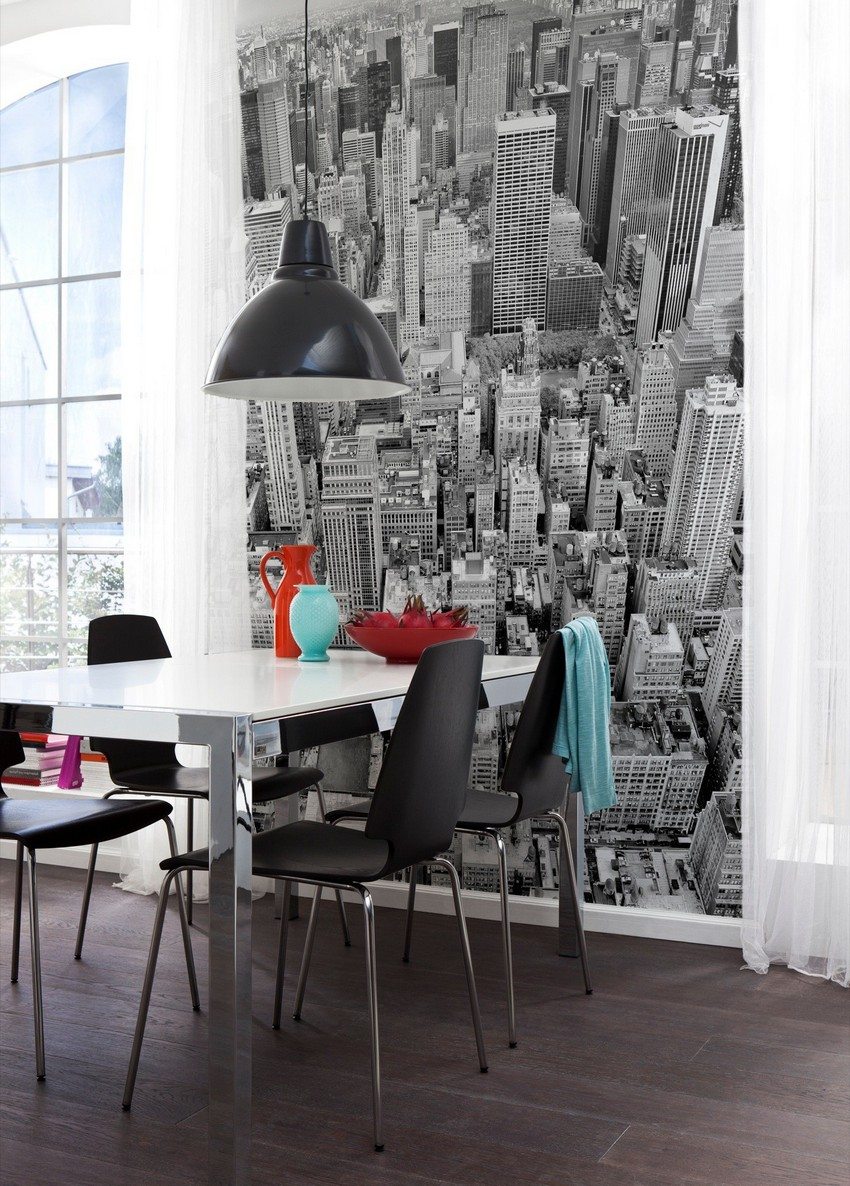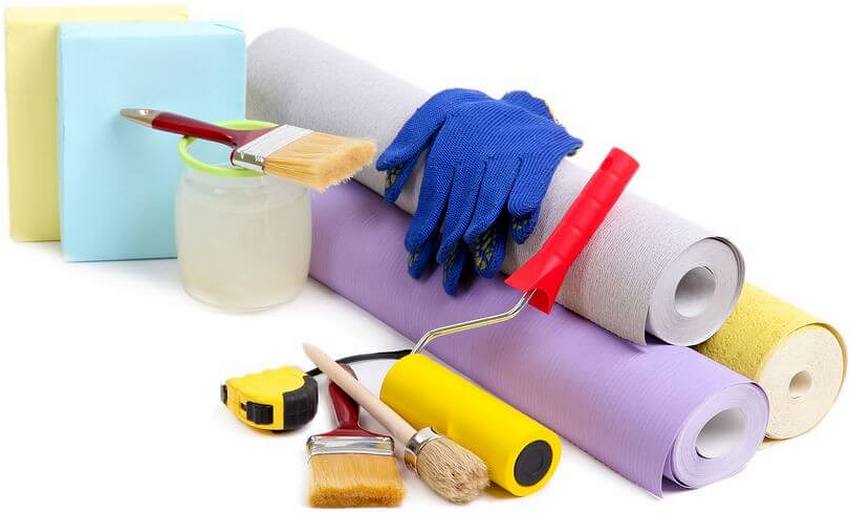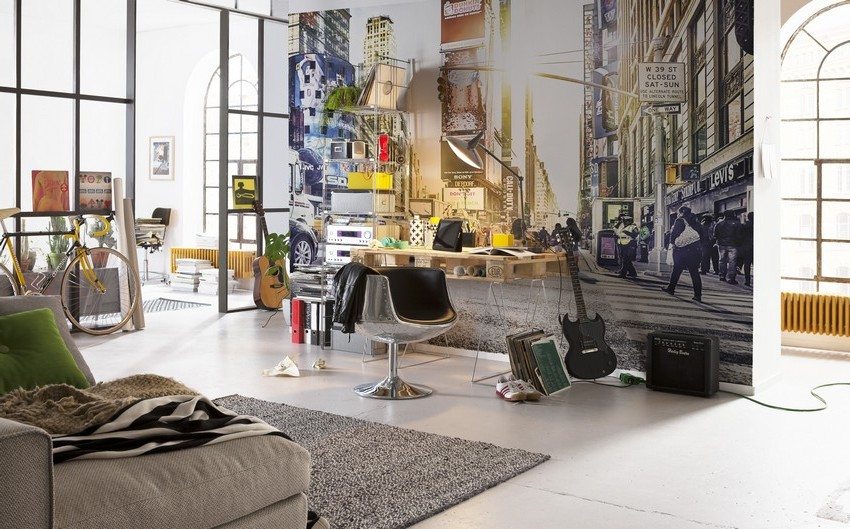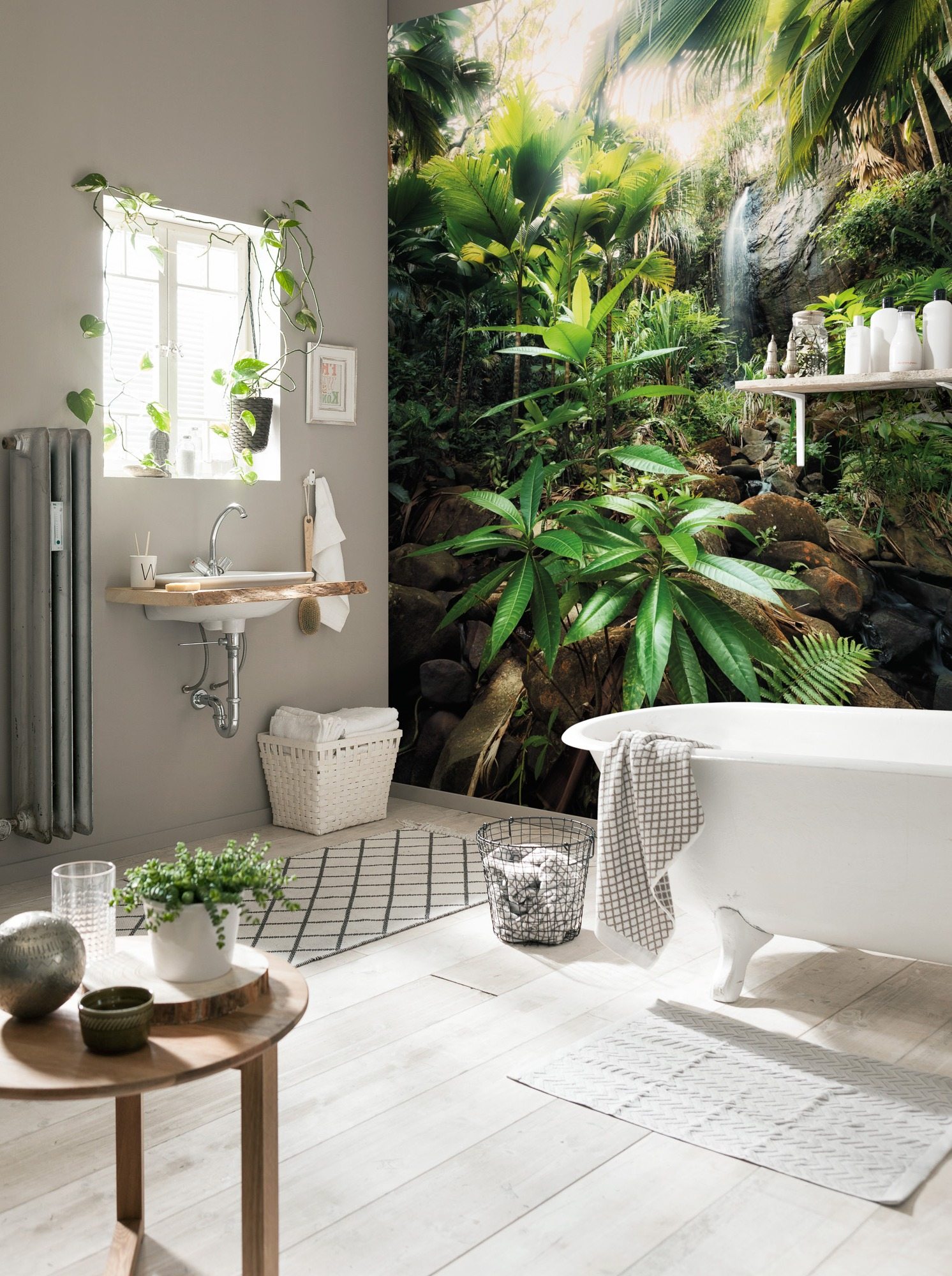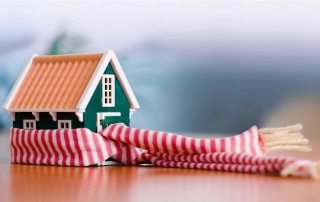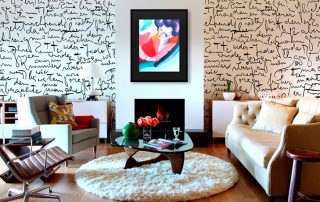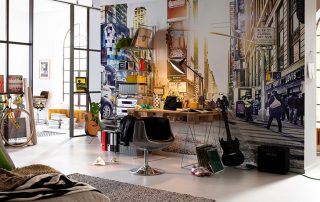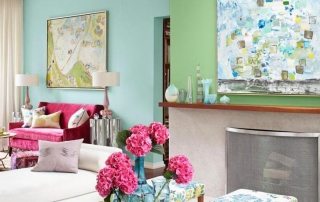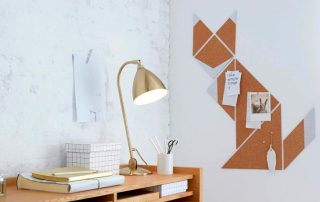Wall murals gained their popularity in the last century and to this day they firmly hold their positions in the design of many houses. Indeed, thanks to its qualities, photowall-paper, expanding the space, is able not only to significantly decorate the room, but also to hide the flaws in the layout. Expert advice will help you figure out what kind of wallpaper are and how to make the right choice.
Content [Hide]
Advantages and disadvantages of using photo wallpaper
Wallpaper have a number of advantages over other wall coverings:
- easy to care for;
- do not fade and do not lose color over time;
- depending on the pattern, they can affect the visual perception of space.
The only drawback of photowall-paper is the relative high cost of the canvas, which does not allow changing them too often. However, this modest disadvantage can be easily eliminated by choosing a coating with a neutral and stylish pattern.
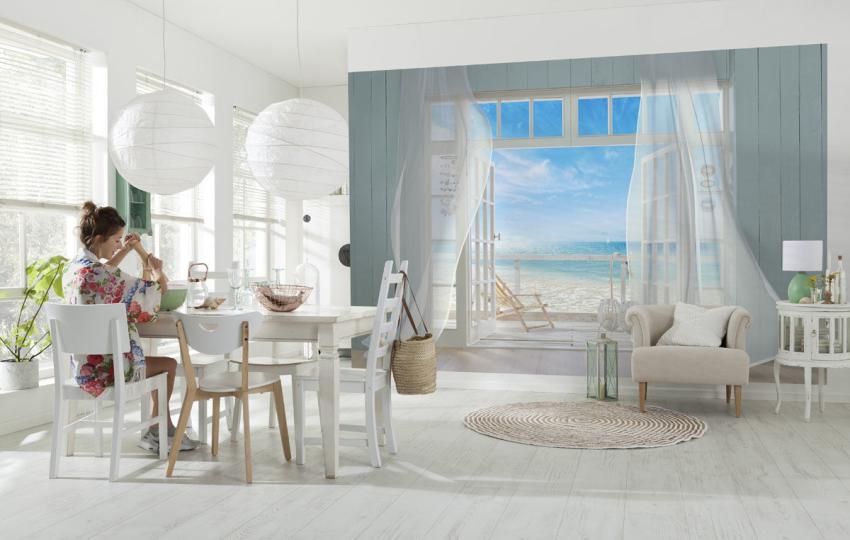
The use of photowall-paper, expanding the space, will allow you to create an original interior in the apartment
The choice of pattern and texture of photo wallpaper
Color, as well as the image on the wallpaper, play a very important role in the visual perception of space. If initially we are talking about expansion, then the use of warm or bright colors is excluded. It is better to give preference to blue, purple, blue or even green.
If we talk about the use of photo wallpaper in the interior in the bedroom (photos will be an excellent model for inspiration), pastel colors, such as beige or very delicate pink, are acceptable.
Helpful advice! When choosing wallpaper, do not forget that colors should be combined with all other interior items.
Contrasts can also be a good solution to running out of space. The right combination of light colored walls and dark floors and ceilings can make a room look wider. True, the height of the room incurs significant visual losses.
For a small square room or kitchen, wallpaper with a large image of one object in the center is suitable. So the room will visually become longer. You can be convinced of this by looking at photos of interior ideas in the kitchen. Wall murals with perspective or unusual patterns almost always look great.
Helpful advice! In order for wallpaper with a promising pattern to look organic and not get out of the general context, select the elements that will connect them. These can be decorative stones (similar to those shown) or similar flooring.
Black and white wallpaper in the interior
Black and white wallpaper will perfectly fit into any interior and make the room more stylish. However, when choosing a color, you must pay special attention to the plot, since such a panel will greatly attract the eye. Specific images are not the best option for small rooms. A traditional photo of a pretty street or some uncomplicated landscape is much more suitable. Naturalistic black and white photographs are your main guide in choosing a picture.
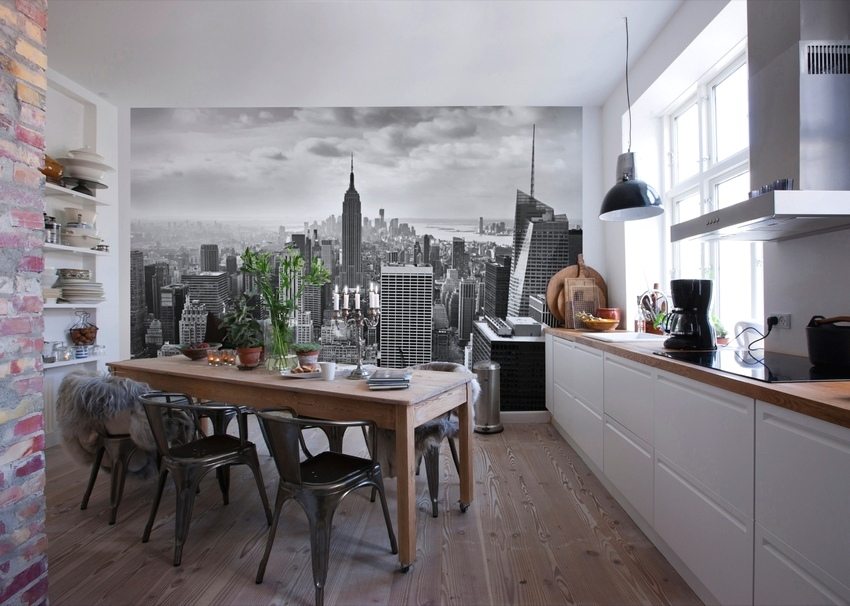
Black and white wallpaper with the cityscape in the interior of the kitchen
Choosing the texture of the wallpaper
Texture is an important criterion for choosing wallpaper. Depending on the texture, the canvases can influence the space in different ways, expanding, or, conversely, visually reducing the room. There are several texture options for this type of wall covering: linen, dust and canvas.
Let's consider the most profitable uses of these surfaces:
- the linen texture is best combined with all kinds of landscapes and photographs of nature;
- “Dust” looks best on bright, large images such as flowers;
- The canvas texture is most often used for photographs depicting architecture.
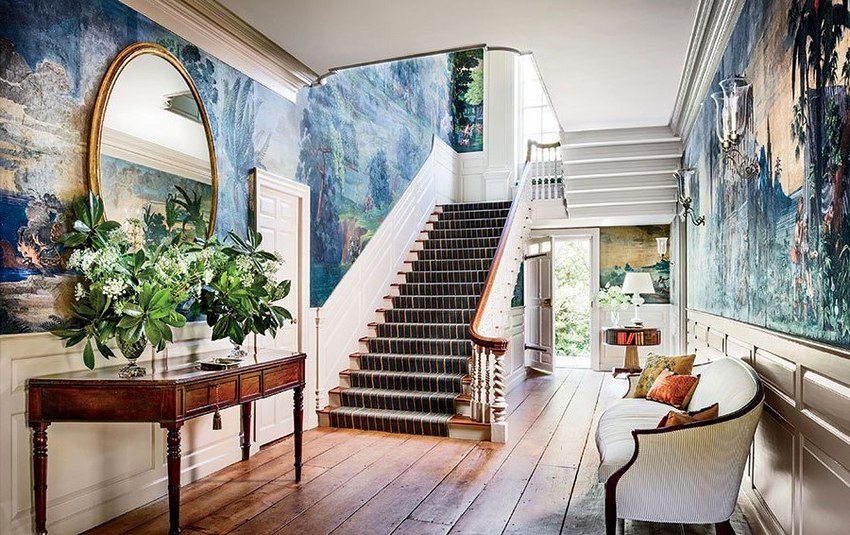
In the lobby of a private house, wall murals were used for wall decoration imitating painting with paints
Speaking about expanding space with the help of photo wallpaper, you need to understand that large-sized drawings in combination with the texture of "dust" are unlikely to help you achieve the desired result. A large object in the foreground will be larger than the furniture, thus narrowing the space.
How to use space-expanding photo wallpaper in the interior
The following designer tips will help you correctly use wallpaper that expands the space:
- if the problem of tightness is very acute and it is necessary to visually increase the space of the room, canvases with a glossy surface are well suited. Wallpaper in the interior of the kitchen this type occupy a special place, since the reflection of objects in the wall covering creates a feeling of additional space;
- it is worth paying special attention to the pattern shown on the surface. Objects or stripes, located vertically, visually "stretch" the height of the ceiling. As examples, you can see the photo wallpaper of the night city in the interior;
- great for decorating canvases that imitate the continuation of a room. The windows and doors depicted on them will give the feeling of additional space outside the wall, for example, in the hallway. Photo wallpaper in the interior demonstrates how successful such a solution can be;
- for rooms located on the sunny side, it is better to purchase wallpaper in cool tones. This will make the room a little darker, but these colors are the best way to expand the space. The presence of a horizon line in the picture is a prerequisite for small rooms.
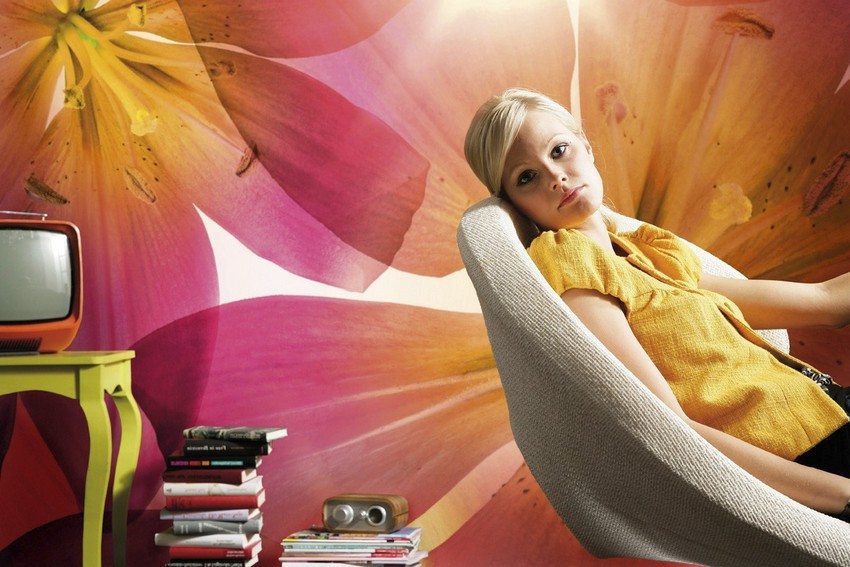
Wall murals are widely represented on the market of finishing materials, which will allow you to easily choose the option that suits you.
Helpful advice! In order for the wallpaper to really affect the perception of space and visually expand it, it is necessary to free the wall from all furniture that can cover the drawing.
There are many options for drawing, and, of course, wallpaper in the interior of the bedroom should be selected on a different basis than, say, wallpaper in the interior of the kitchen. Photos and recommendations of experts will help you make the right choice to decorate any room with advantage.
Photo wallpaper in the interior of the living room: photos and ideas of unusual design
One of the most common rooms where wallpaper is glued is the living room. Firstly, it often requires a visual expansion of the space, and secondly, it is a great way to decorate the wall without cluttering it with unnecessary furniture.
The most common type of wallpaper in the living room interior is landscape photography and panoramic shots. They are widely used for the design of modern interiors in the style of high-tech photo of the night city. In the interior, photomurals of this theme look especially advantageous and stylish. You can often find pictures taken from a great height.

Bright photo wallpaper in the interior living room will delight the eye and create a festive mood
The seascapes and ocean landscapes, mountains and forests, flower fields and various exotic islands depicted on the wall mural are an opportunity to create another, parallel world in the room that can give you a qualitatively new rest.
To make the image even more realistic, use a variety of lighting options. It can be both the simplest and complex LED designs. The correct placement of lighting can significantly affect the perception of walls.

Depending on the pattern and color, wallpaper can have different effects on the sense of space in a room.
The first way is to place spotlights directly above the drawing. An additional wave of light will add volume and realism to the image. As an option, you can install a dimmer instead of the standard switch. This will allow you to adjust the light intensity.
The second (more complicated, but at the same time, better quality) option is the use of LED strips. They can be positioned both along the entire perimeter of the picture, and along its individual edges, depending on the image. But the complexity of this method implies additional design of niches in which the light source will be located. If such a niche is not made, the lighting may turn out to be too bright and the goal will not be achieved.
The most difficult options for the design of photo wallpaper include the highlighting of individual elements, for example, the windows of a night city. Such work requires special professionalism.
Photo wallpaper in the interior of the kitchen
Apartments with a standard layout and one of the smallest rooms often have a kitchen. And since all family members gather at the dinner table at the same time, the kitchen needs expansion (at least visual). And the wallpaper here is your best assistant.
The first thing to consider when choosing photo wallpapers for the kitchen is the material from which they are made, as well as the quality of their manufacture. The kitchen is a place where there is a lot of moisture and dirt, so you will have to wash the surface much more often than in any other room.
The wall covering for such a room must perfectly withstand moisture and temperature changes. Therefore, a vinyl or non-woven backing is best. At the same time, the dyes that are used to print the picture must be moisture resistant, otherwise the picture may soon "float" from the water. And UV-curable ink will help keep the wallpaper from fading throughout its lifespan.
Helpful advice! An interesting option for decorating a kitchen can be voluminous 3D wallpapers.
As a decoration of the kitchen, you can use photowall-paper, making only kitchen apron... If the kitchen is angular, then the furniture will visually seem deeper. However, remember that only panels with three-dimensional or neutral patterns expand the space. Large bright images, on the other hand, will bring the wall closer.
DIY photo wallpaper
Let's say you have chosen a wallpaper that fits perfectly with your interior. But what about next? Seek help from professionals or try to do everything yourself? It is not so difficult to glue the wallpaper with your own hands. It is enough just to adhere to certain tips and follow the phased process.
Particular attention should be paid to the choice of glue. Modern photo wallpaper manufacturers offer many different types of canvas, each of which requires its own suitable adhesive. The ideal option is to purchase the glue recommended by the manufacturer. This will give you the assurance that over time the coating will not peel off or fall behind. However, the general principle for choosing an adhesive can be formulated as follows: the thicker the wallpaper, the thicker the adhesive is needed.
Useful advice! In order to achieve perfect gluing of the canvas on the wall surface, pay attention to the instructions that will be attached to the kit. Do not ignore the advice of manufacturers in your work.
Prepare the walls before gluing. If the wallpaper is thin, all irregularities and roughness must be smoothed out, otherwise they will show through. Thicker wallpaper can hide minor flaws in the walls. The main thing is to clean the surface as much as possible from the remnants of old wallpaper, dust and dirt. If necessary, you can use a stiff brush.
Related article:
Primer for walls for wallpaper: composition, types and their characteristics. What types of primers are available, their main properties and types of wall surfaces for which they are best suited. Review of manufacturers.
On the forums, you can often find discussions on whether it is possible to glue photowall-paper over an old coating. The unequivocal answer from experts is no. This alignment can adversely affect the lifespan of the blade. In addition, there may be a problem with the fact that the new wallpaper will not be dense enough, and the pattern of the old ones will shine through and spoil the photo image. The best option is to paint the wall white. Against this background, the colors of the picture will be as bright and saturated as possible.
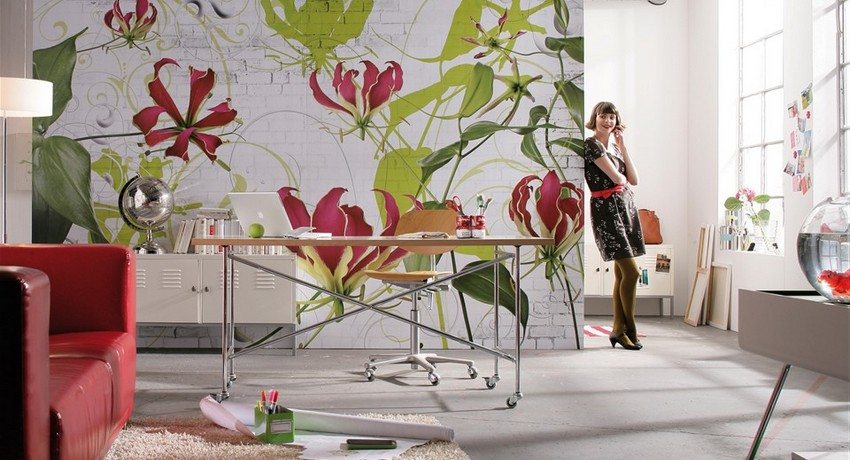
Front gluing photowall-paper it is necessary to clean the wall from the old coating and paint it white
Stages of gluing photo wallpaper on the wall
Wall murals are glued according to the following algorithm:
- trimming white margins that appear on any canvas. For this it is best to use a sharp stationery knife and a ruler, as scissors can create bumps;
- using a level and a simple pencil, it is necessary to mark a straight line on the wall, which will serve as a guide for the edge of the canvas;
- having previously laid the floor, it is necessary to lay out the wallpaper on it, pattern down;
- the glue diluted according to the instructions is applied first to the wall surface, and then to the wallpaper. Let the canvas soak for 5-10 minutes;
- focusing on the drawn line, we glue the first canvas;
- using a roller, you need to smooth out the pasted part of the wallpaper. You can only use a special roller for this, since ordinary sponges can ruin or stain the drawing;
- all the following canvases are glued according to the same principle, only focusing not on the line, but according to the pattern. Each next layer is overlapped. It should match perfectly, creating the appearance of a single whole image;
- using a ruler and a knife, make an even cut along the entire height of the wall where the wallpaper overlaps in such a way that both layers are cut. Remove the top one;
- using a brush, cover the joint.
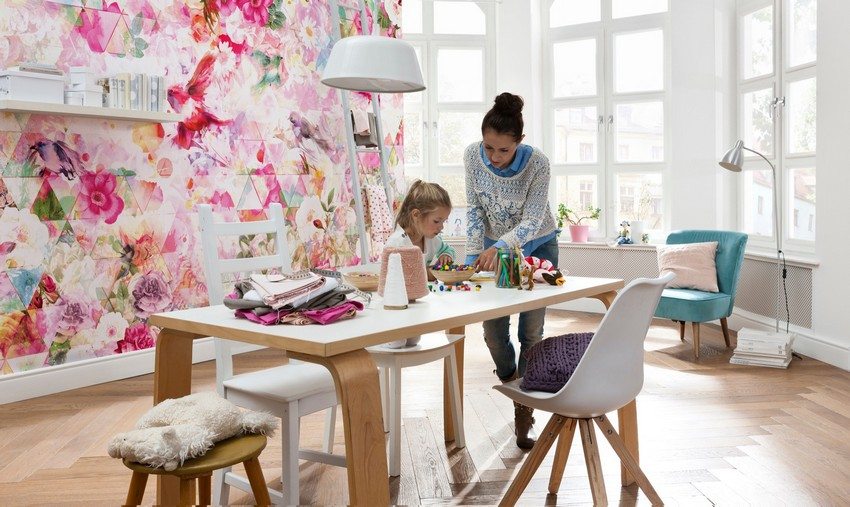
Bright photo wallpaper in the living room harmoniously combined with snow-white walls and light furniture
Useful advice! The room where the wallpaper was pasted should be warm and dry. It is best to refrain from airing until the glue is completely dry.
Another option for photo wallpaper is a self-adhesive canvas. At first glance, it may seem that this option is more acceptable for beginners. However, it is not. After removing the paper protection, you must act very quickly and clearly. But the most difficult thing is that the glue layer on such photowall-paper sets immediately after contact with the surface, which gives no room for error. It will no longer be possible to tear off and fix such wallpapers, and given the considerable cost of such a canvas, it is better not to risk it if you are not confident in your abilities.
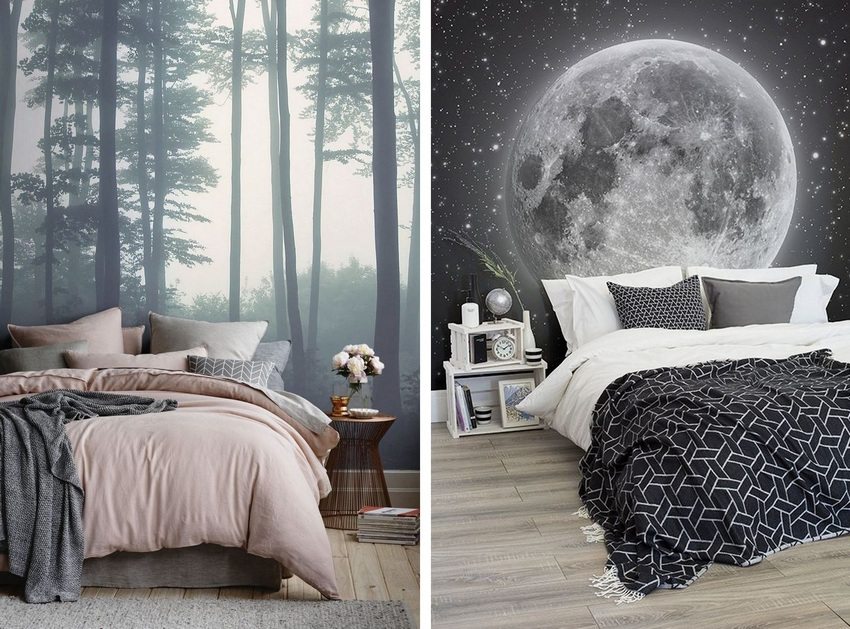
Wallpaper with black and white print in the bedroom interior
When it comes to the design of small-sized rooms, properly selected wallpaper can be an ideal solution to the problem of a small area. Simple but original images will become not only a decoration, but also a way to "push back" the wall. Therefore, when choosing a photo wallpaper, first of all, you must be guided by the basic rules for expanding space. However, do not forget about your own tastes, because this element of the interior will fulfill its function only if it pleases you.
